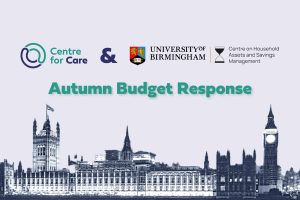The National Children’s Bureau, a Policy and Practice Partner for the Centre for Care, has recently published the findings of an evaluation (https://www.ncb.org.uk/what-we-do/research-evidence/our-research-projects/evaluation-support-care-leavers-insecure) (Clements et al 2022) of support for young people leaving state care with insecure immigration status in England. The evaluation, funded by Paul Hamlyn Foundation, looked at the work of 4 charities in partnership with 5 different local authorities across the country. It sheds light on the needs of young people and those supporting them, as they negotiate three key transitions: becoming aware of the realities of insecure immigration status, negotiating the ‘cliff edge’ of support faced by young people as they turn 18, and embarking on collaborative practice between local authority and voluntary sector staff.
Becoming aware of the realities of insecure immigration status
There are no official published data on total numbers of care leavers with insecure immigration status in England. The results of a Freedom of Information Request (South London Refugee Association and Coram Children’s Legal Centre 2022) suggests that there are at least 18,934 looked after children and care leavers who are not British citizens, meaning they have a potential immigration or citizenship issue to be resolved.
A significant minority of these young people arrive unaccompanied as teenagers, seeking protection and safety. Literature (For example: Allsopp, Chase & Mitchell 2015); Sigona and Hughes 2012) alongside our own evaluation, illustrates the differential experiences these young people have compared to their peers. As may be expected, given the trauma they have undergone in their home countries, on their journey to the UK and on arrival, these experiences include social isolation, bereavement, and emotional or mental health problems. They can also include discrimination and racism, and difficulties accessing services. In response to this, a significant part of charities’ offer for these young people focusses on practical support and positive activities enabling young people to acclimatise to life in the UK and build their own informal support network. As these young people are looked after by local authorities alongside other children in care, supporting young people with these issues is an important part of councils’ corporate parenting responsibilities.
Unaccompanied arrivals are not the only group of children in care who find themselves approaching adulthood with insecure immigration status. The majority, in fact, have been taken into care from their birth families in the UK, due to concerns over their welfare. Our evaluation indicated that identifying instances of insecure immigration status, so that the right support can be provided, remains a challenge for local authorities. Some of these young people have arrived with their parents in the UK at a very young age and have grown up seeing themselves, their friends and family as British. Recent reflections on the Windrush scandal have illustrated in stark detail how lives can be turned upside down by the questioning of such people’s right to remain in the UK.
Until their status is resolved, which can take years, young people with insecure status face uncertainly regarding their futures. All young people in care who are approaching adulthood are supported through a process of ‘pathway planning’ to ease the transition to having more independence and less support from carers and social workers. Guidance recommends a process of triple planning for young people who have not yet had their status resolved – setting out plans to accommodate three different eventualities:
- Being granted leave to remain
- Not being granted status and being able to return to their country of origin
- Not being granted status and not being able to return to their country of origin
Not surprisingly, having to contemplate such a range of outcomes can be overwhelming for young people. Staff and young people we spoke to throughout the evaluation made clear that this uncertainty was a great source of anguish. For those experiencing it, the resulting mental and physical health concerns exacerbates their difficulties. Managing these concerns becomes a major focus of the care these young people require.
Negotiating the ‘cliff edge’
Those working to support young people with any kind of additional needs will be familiar with the concept of a ‘cliff edge’ of reduced support from public services when those young people turn 18. Whilst all care leavers see reduced entitlements to support when they turn 18 the implications for those with insecure immigration status are even more far reaching.
To start with, legal aid and immigration rules tighten, making the process of resolving status harder for young people once they are adults.
Day to day support also takes a bigger hit. As part of the ‘hostile environment’ policy introduced around 10 years ago, increasing numbers of those who do not have long term permission to remain in the country are deemed to have ‘no recourse to public funds ’. The 32 local authorities participating in the NRPF Connect database reported supporting 856 care leavers with no recourse to public funds during the period of our evaluation. These young people are generally not entitled to welfare benefits to support with housing or living costs and are unable to access free healthcare on the NHS. This creates a perilous situation for care leavers who are expected to live largely independently from their 18th birthday. Thankfully for some young people, under social care and human rights legislation, local authorities retain some responsibility for their welfare, and mitigating support is put in place (Section 23 C of the Children Act 1989 and Articles 3 and 8, for example – also see Coram Children’s Legal Centre 2017 & 2018). Project staff at charities we interviewed, however, reported that many young people had lost contact with the local authority that took them into care, and as a consequence were faced with destitution.
These most damaging aspects of the ‘cliff edge’ can be avoided through early identification and support for the relevant young people. We heard through our evaluation, however, that social workers found the prospect of addressing young people’s immigration needs daunting. There are many complexities involved in understanding which path to settlement a young person should be pursuing and what action is required and when, to ensure this is progressed in a timely fashion (see Dorling, MacLachlan & Trevena 2017). We heard that staff were also sometimes unsure of their authority to offer support with this, fearing conflict with immigration authorities.
In our study, training offered by the charities supported local authority staff to understand the basics of the immigration and asylum system and what this meant for their responsibilities. Local authority staff valued this training and ongoing guidance, not least in recognition of how it could reduce young people’s support needs in the longer term and save money. Our analysis of NRPF Connect data found that it cost local authorities an average of £44,931 for each young person who ended up with no recourse to public funds. Our report details specific examples of early and late intervention and the associated differences in legal, administrative and support costs.
Moving towards collaborative practice
Local authority staff found that there was much to be gained from ongoing collaboration with charities. Whilst training was seen as effective and raised awareness, staff also welcomed the opportunity to coordinate support for individual young people and engage in dialogue to discuss the support they needed. The Immigration advice offered by the charities is, after all, a highly specialised and regulated profession (https://www.gov.uk/government/organisations/office-of-the-immigration-services-commissioner). It is part of a social worker’s role to support young people on their caseload to access it, and those social workers we spoke to were clear that even with increased awareness from training, they themselves could offer little direct support to young people in this area.

Furthermore, some challenges around identification and early intervention could only be addressed at a whole-service level. With relationships strengthened through training, guidance and coordination to meet individual needs, local authority and charity staff were able to work together to identify solutions to these challenges. For example, charity staff used their expertise to advise senior local authority colleagues on the design of standard data collection tools on nationality and immigration, and to secure improved support offers from the local authorities for this group of young people.
That the organisations were able to work in this collaborative way is all the more notable given that the charities had historically made legal challenges to local authorities on their practice – and continued to do so. A key point of conflict in these situations is the quality of age assessments undertaken by local authorities. These are carried out to determine whether an undocumented arrival who claims to be a child is to be officially deemed one, and therefore if they are entitled to the relevant support. Charities are often concerned that the assessments have not been conducted fairly from the perspective of the young person through, for example, not explaining the purpose of the assessment, not providing an interpreter or relying too much on physical appearance as an indicator of age (ADCS, 2015). In spite of these ongoing challenges, staff accepted and respected each others’ roles in the wider eco-system of support.
Continuing their collaboration journey, towards the end of the evaluation period, charity and local authority staff were able to combine both individual and service level approaches to collaboration to address a looming crisis for many looked-after children and care leavers. They worked together as ‘partners in a community of practice’ to ensure that hundreds of children of EU citizens were identified and submitted to the EU Settlement Scheme. This intensive work helped a whole new cohort of young people avoid the potential challenges of leaving care with insecure status.
Learning for care organisations and professionals
Our evaluation report makes a range of recommendations, for charities, funders, local authorities and local government. Recommendations to support collaborative practice include:
- Charites developing an offer for local authorities that speaks to their shared interest in early intervention to resolve immigration status of care leavers
- Local authorities commissioning charities’ training and guidance for staff , as well as the immigration advice for young people that they have historically commissioned
- Local authorities prioritising continuity of care for affected young people
- Both charities and local authorities maintaining joint fora at strategic and practitioner level to share insight and solutions
These findings and reflections of course point to important learning for the wider care workforce in terms of work with those who have complex support needs. They illustrate that, at least for some of those who receive care, not of all of their needs can be met by one person or organisation. They also demonstrate, however, that, with time, mutual respect and commitment, the requisite multi-disciplinary teams can be established.
References
- Allsopp, J., Chase, E. and Mitchell M. (2015) ‘The Tactics of Time and Status: Young People’s Experiences of Building Futures whilst Subject to Immigration Control in Britain’, Journal of Refugee Studies 28(2): 163 – 182
- Association of Directors of Children’s Services (2015) AGE ASSESSMENT GUIDANCE: Guidance to assist social workers and their managers in undertaking age assessments in England. (see, in particular, notes on case law pp58-65) https://adcs.org.uk/safeguarding/article/age-assessment-information-sharing-for-unaccompanied-asylum-seeking-children
- Clements, K., Munro, G., Berry, A., Davis, L., Lyons, F. and Nugent, R. (2022) Supporting care leavers with insecure immigration status: Learning on effective support, collaboration and empowerment. London: National Children’s Bureau and Paul Hamlyn Foundation. https://www.ncb.org.uk/what-we-do/research-evidence/our-research-projects/evaluation-support-care-leavers-insecure
- Coram Children’s Legal Centre (2017). No Recourse to Public Funds. Available at: https://www.childrenslegalcentre.com/wp-content/uploads/2017/05/NRPF-conditions-Apr.2017.final_.pdf
- Coram Children’s Legal Centre (2018). Coram Migrant Children’s Project fact sheet, ‘Leaving care support for migrant children and young people’. Available at: https://www.childrenslegalcentre.com/wp-content/uploads/2018/06/Leaving-Care-Support-June-2018-FINAL.pdf Last accessed November 2018
- Dorling, K., MacLachlan, S., and Trevena, F (2017) Seeking Support a guide to the rights and entitlements of separated children. London: Coram. https://www.childrenslegalcentre.com/wp-content/uploads/2017/05/Seeking-Support-2017.pdf
- Sigona, N and Hughes V, (2012) ‘No way out, no way in: irregular migrant children and their families in the UK’, Centre on Migration, Policy and Society, University of Oxford
- South London Refugee Association and Coram Children’s Legal Centre (2021) Taking Care: How local authorities can best address immigration issues of children in care.
Keith Clements is a children’s health and social care policy expert and social researcher. Keith joined the National Children’s Bureau (NCB) in 2009. He led NCB’s policy influencing activity in relation to health, social care and services for disabled young people before joining the charity’s Research team in 2016. From 2018-2022 he delivered an evaluation of four voluntary sector initiatives to support care leavers with insecure immigration status, with a particular focus on collaboration with local authorities. Keith oversees NCB’s Families Research Advisory Group – a forum for parents to inform research design and messaging – alongside wider work to involve policy and practice stakeholders and people with lived experience in social care research.





